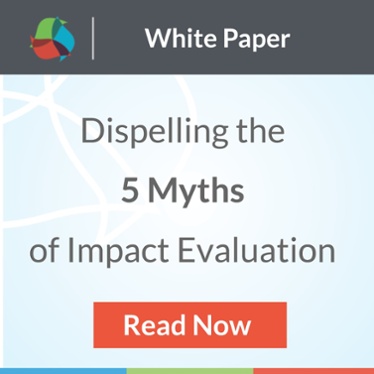
As we finish up yet another informative and exciting GMN ... err … PEAK Grantmaking conference in Hollywood and head back to our day jobs, I’m left reflecting on my experiences talking to and learning from a crowd of really smart people, committed to solving some really important issues in society.
If you know me, you know I eat, sleep, and live data, measurement, and evaluation. So, in addition to discussing the journey to measuring impact with the Arcus Foundation and Farash Foundation during our panel session, I took every opportunity to talk to as many people as I could about their experiences with data and measuring impact at their foundations.
I learned many things during these conversations, including how frustrating and confusing the work can be, that everyone wants to do the work in a meaningful and appropriate way, and that impact can mean different things to different people. The conversations also reinforced my belief that many foundations are being inundated with calls to become data-driven and to conduct impact evaluations. This one was especially important to me because, in reality, not every grantmaker is ready for impact evaluation.
And to that I say, “It’s okay.” You may not be ready for impact evaluation right now, but that doesn’t mean that you are not ready to begin the journey – to begin taking the necessary steps to prepare for measuring impact. So with the journey in mind, I’ve laid out a couple steps that I think will help you get started.
START THE CONVERSATION For those grantmakers who have not embarked on their journey to measuring impact, the best place to start is by gathering everyone around the table to begin talking about impact. And when I say “everyone,” I mean every team, because you will find that each team (and some individuals) will define, approach, and value impact differently. This is not a bad thing. In fact, it’s great. Because in addition to better understanding impact across your teams, this kind of rich conversation begins to build a collaborative data culture at your organization and starts to tear down the walls that exist between teams.
BE AN IMPACT AMBASSADOR When you meet with your colleagues, talk about your work and what impact means to your team and to the broader sector. Talk about what you are doing, your approaches, the change you believe could, and should, occur as a result of your work. Also talk about the organizations and partners you work with, what activities they do, what resources they need, the communities in which they work, their challenges, and the lessons learned.
You’ll likely begin to see similarities in the types of challenges you and your grantee partners face. This gets your organization thinking beyond one program or grant and recognizing the value of sharing information across the sector.
CONNECT THE DOTS Once your teams begin to share with each other (both across programs and across operational departments), begin linking the work together. Are there similar goals and approaches? Are teams working in the same communities or with the same groups and organizations? Are there similar issues and challenges across teams? These could be clues to factors that should be considered across teams and contexts. I’ve seen this done many ways but one of the best is through the development of an impact committee – with members from each team – working together to link this data and information and identify similarities and trends. This group could develop periodic reports or updates for the staff to keep them informed and to spur additional conversations and collaboration.
DEVELOP AN INITIAL FRAMEWORK Once the dots begin to connect, much of the data and information you’ve captured can be used to build your initial framework for an organizational, programmatic, or funding program. From here, each team can begin to fill in the missing pieces: What is the relationship between the activities that your grantees do and the outputs you expect to see? How do the outputs then lead to the outcomes that your team has identified as evidence of the change you believe will occur? The framework will not be complete and you may not have all of the information that you need, but it’s a great start. As time goes on and you learn more about your work, your team can fill in or revise the information.
This should be done routinely – maybe once a quarter to start just so that information and insights are not lost. You could even send out periodic reminders to enter information in a spreadsheet where this information resides. Over time the framework will become more detailed and specific and, hopefully, revisions become slight and infrequent. That is when you know that you’ve developed something appropriate and meaningful.
The best part is that in addition to creating the basis for an impact evaluation framework, you have also enhanced the collaborative culture of your staff within and across teams. Organizations that collaborate and share are not only better informed, but they are also more efficient as they eliminate significant amounts of time and resources searching for information, data, or expertise.
Another benefit of this process is that – as result of the collaborations and capturing of data and information – you have established a framework for knowledge management. These insights often reside in the heads of program or grants managers who are focused on specific grants or routine activities and not often thinking about how it affects or could influence the work of others.
I know that this is a lot of work and can sometimes be frustrating and confusing. But this should not prevent you from taking that first step. These recommendations will get you moving in the right direction and – over time and with a continuous commitment to learn and inform – you will be well on your way to measuring impact in a way that is both meaningful and appropriate for your organization.
